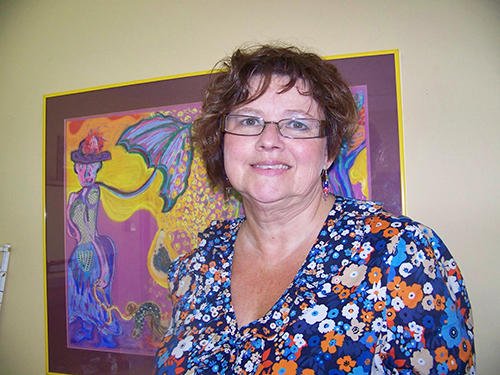 Sitting in her art-laden office at the Kingston Seniors Centre, Jo-Anne Lachapelle-Beyak, M.Ed.’06, Ed’08, lets out a wide smile.
Sitting in her art-laden office at the Kingston Seniors Centre, Jo-Anne Lachapelle-Beyak, M.Ed.’06, Ed’08, lets out a wide smile.
“I’ve had an interesting career,” she says.
Now the director of programming at the SAKR where she oversees the development and implementation of more than 150 different arts, culture and fitness programs, Jo-Anne has taken anything but a straight path to get there. An artist, a trained opera singer and an actress, she’s worked at museums and art galleries across Ontario and in Quebec.
After earning a BA in fine arts/anthropology from Concordia University, Jo-Anne, who has always had a keen interest in museums and exhibitions, pursued a diploma in museum technology from Algonquin College. From there, she moved to north-western Ontario to Atikokan, a town of about 3,000 people buoyed by mining, forestry and the operation of a hydro generating plant.
Working at the Centennial Museum, Jo-Anne learnt that a number of the town’s residents were interested in theatre. Wasting no time, she helped with the establishing of a theatre company to put on plays. “We were a small operation, but we had a lot of interest,” she says. “We did a rendition of Sleeping Beauty where I played the evil witch. I had this long grey hair with purple streaks and a great big bat-like cape. For months afterwards kids would see me on the street and shout, ‘Mommy! It’s the witch!’ It was great.”
Later moving back down south, Jo-Anne spent time at the Art Gallery of Northumberland and Kingston’s Marine Museum before deciding to come to Queen’s for her Master’s degree. Working with an eighth grade class at Our Lady of Lourdes Catholic School, she taught the students to put on a personalized exhibit that combined the curriculum of their geography and history classes. Each student was responsible for detailing their family’s immigration history to Canada and turning an antique suitcase into a display that told their story.
Years of museum programming and curating made the project a natural fit and allowed her to explore the possibilities of unconventional teaching practices. “I wanted to find out if students would learn better by utilizing these more creative processes. It was important to me that though I taught them the concepts of curatorship, they were the ones making final decisions about staging and organizing the exhibit,” she says. “Not long ago I saw one of those students, now studying at university, and he told me it was the best thing he’d ever done in school.”
With degree in hand, Jo-Anne kept herself busy working at the Agnes Etherington Art Centre, the MacLachlan Woodworking Museum and the Kingston Arts Council, to name just a few, all while raising her two children. When her Master’s supervisor, Stephen Elliott, Dean of the Faculty of Education, told her about the Artist as Community Educator (ACE) program, it sounded worth pursuing.
Once enrolled, Jo-Anne felt right at home.
It was absolutely the right fit for me and I don’t think I would have succeeded elsewhere. ACE gave me a lot of leeway and a lot of space for creativity. I don’t do well with strict rules and I don’t like to do things the same as everyone else, so I was able to use all my talents and interests.
The perspective ACE provided in joining teaching and art meshed well with Jo-Anne’s educational style. “When teaching people, you need to capture their attention. Everything happens at a fast pace today and if you can’t keep up with it, then you can’t keep the students engaged,” she says. “Getting them involved, varying the activities, utilizing theatre techniques, these are all things a teacher can do to keep their classes interesting. Taking part in ACE impressed upon me the rewards that pushing educational boundaries can have. It’s helped me to do my job better wherever I am.”
Article originally appeared on the Queen's Alumni Review website.